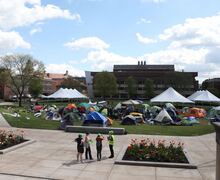From its original construction to now, here’s everything you need to know about I-81
Meghan Hendricks | Photo Editor
Last Thursday, a state supreme court justice issued a decision to halt the I-82 viaduct removal and community grid replacement project in consideration of a lawsuit filed by the group "Renew 81 For All."
Get the latest Syracuse news delivered right to your inbox.
Subscribe to our newsletter here.
In 1958, Syracuse invested federal funds in Interstate 81 despite community backlash. As a result of its construction, over 1,300 families were displaced in the predominately-Black historic 15th ward.
Over 60 years later, the state plans to deconstruct the viaduct and replace it with a community grid of surface level streets. Last Thursday, New York State Supreme Court Justice Gerard Neri issued a decision to pause the project, based on a temporary restraining order to halt building efforts, preventing the New York State Department of Transportation from beginning construction to tear the highway down.
The Daily Orange compiled a timeline of I-81’s history in Syracuse, from the beginning of its construction to the recent pause to its demolition plan.
1960s
When former President Dwight D. Eisenhower first proposed an interstate highway system, Syracuse put forth a bid to receive federal funding to build its own highway. Federal and state officials decided the interstate would run above the city.
The 15th ward was a Black neighborhood of the city that was economically thriving, although labeled a “slum” by the city. Once the city announced the construction of the highway, citizens and local leaders protested, but the 15th ward was demolished to pave way for the highway, creating a division in the middle of the city with impacts still seen today.
Phase one began in 1959 with the construction of a one mile stretch of the highway. Most of the highway was constructed in short mileages going through phase two and three until it was finished in 1969. CNY’s 2020 Fair Housing showed a 26% increase in the number of census tracts, or small subdivisions of neighborhoods, with racially-concentrated poverty from 1930 to 2019. Today, the area west of I-81 has one of the highest concentrations of Black and Hispanic poverty rates in the United States.
1970-80s
I-81 soon became a major highway in the northeast, when in the 70s it began to record traffic of up to 70,000 vehicles daily. Ten more miles of highway were constructed to accommodate the increasing number of travelers, and two lanes were added to the existing four.
By the early 80s over $100 million from the beginning of its construction to then had been spent on the viaduct’s construction and on enhancements, which required halting traffic during the rebuilding, according to the Transportation Research Board.

Megan Thompson | Digital Design DIrector
2013
The highway that now runs through downtown Syracuse began to deteriorate over 50 years after its original construction.
A 2013 state DOT study, entitled The I-81 Corridor Study, deemed that of 76 bridges located along I-81 and I-690, 9% were structurally deficient and 60% were functionally obsolete. Eighteen of those bridges were in the viaduct section of I-81 that goes above ground in downtown Syracuse.
Michael Tuttman, a civil engineer from a transportation engineering consulting firm, told The D.O. at the time that “it’s time for these structures to be replaced.”
The bridges were only constructed to have a lifespan of over 50 years, The D.O. reported, but by 2013 they were approaching 56 years old.
2016
As the highway system approached its 60th anniversary, increasing deterioration exacerbated by weather prompted the city of Syracuse to begin considering potential changes to the interstate.
NYSDOT at the time discussed replacing the highway with a tunnel to direct traffic underneath Syracuse, similar to Boston’s “Big Dig,” but dropped the idea out due to its high cost.
Following the department’s decision, then-Gov. Andrew Cuomo attempted to bring the idea back, saying he wanted the plan reviewed by an independent consultant. Following the consultant review, the tunnel plan was dropped again and replaced by NYSDOT’s community grid suggestion.
The community grid alternative required tearing down I-81 and allowing the traffic to be dispersed through other existing city streets as well as I-481, which would take on the original name of I-81. Almond Street would then become a more accessible street with “new bicycle and pedestrian amenities, ” according to NYSDOT.
2019
In 2019, the NYSDOT recommended the community grid after finding it would be the cheapest and most time-efficient option, costing a projected $1.9 billion and estimated to take 5 years to complete.
A 45-day public comment period for community members to ask any questions or provide any comments on the project succeeded the state’s decision. Public comments were intended for review and release in a 2020 report, but the report was never compiled and released to the public.
2021
After delays due to the COVID-19 pandemic, Cuomo announced that the community grid plan for I-81 was set to happen, with Syracuse Mayor Ben Walsh echoing his statements. $800 million of the state’s budget was allocated for the renovations and the first phase of construction was set to start in 2022.
Walsh told opponents of the project that people needed to get on board with the idea itself before concerns could be addressed. People against the idea had a fear of a similar displacement situation happening to that of the original construction of I-81, The D.O. reported at the time.
“It’s critically important that, right now, those that haven’t been willing to accept that the community grid is going to happen need to come to that conclusion,” Walsh said. “Because the sooner they do, the sooner that I and other representatives can work with them to address any outstanding concerns.”
In November, President Joe Biden’s infrastructure bill passed, which included $11.5 billion highway funding for New York state. The plan also included $7.5 billion in new funding for the Rebuilding American Infrastructure with Sustainability and Equity program, which I-81 would have been eligible to receive.
2022
In April, the new budget for the state allotted $1.1 billion to remove the viaduct. That same month, the project released an environmental impact statement which established the construction would take six years to complete and take place in two phases.
The Federal Highway Administration officially approved the Community Grid Alternative of the Interstate 81 Viaduct Project in May.
On Nov. 10, State Supreme Court Justice Gerard Neri granted a temporary injunction, stopping the construction of the community grid before it was slated to start in fall 2023.
In an email to The D.O., Syracuse Mayor Ben Walsh called the delay unnecessary.
“It risks a setback to local people who need the jobs and opportunity that the $2 billion-plus infrastructure investment will create,” he said.
Published on November 17, 2022 at 2:06 am





